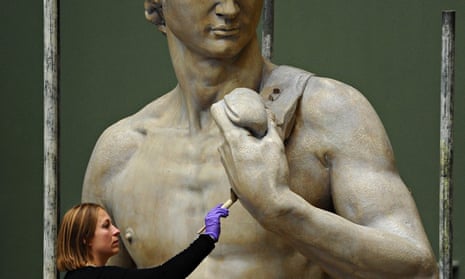Your piece (Why do we only worship ‘real’ works of art?, 14 November) refers briefly to Walter Benjamin’s analysis of infinitely reproducible art but doesn’t mention his worry that modern mass reproduction could eventually erode the historical authority of an artwork, jeopardising its traditional testimony as part of a time-tested canon. Indeed, he feared a wider decline of the value of human experience, as once passed between generations through careful storytelling. With today’s instant internet access to countless images and information, a serious debate over a related loss of historical memory and understanding is now growing at last. Great art is not immune to this erosion. It forms a key part of our social memory.
John Chowcat
Wakefield, West Yorkshire
The piles of glossy art books on sale show that many people enjoy looking at good-quality reproductions of their favourite pictures, even though they would not find it acceptable for the same reproductions to be framed and hung in an art gallery for an exhibition. Many would, however, be happy to hang a good quality reproduction on their walls at home. This surely relates to how we value objects and what we think is worthy of our attention. The bottom line is that we place a much higher value on things that are rare or unique, provided they speak to us in some significant way.
John Gaunt
Lewes, East Sussex
We shouldn’t be dismissive of reproductions of great works of art, which might make them more accessible to the public and are art in their own right. What we should dismiss are cheap imitations of iconic designs. The government is yet to implement legislation it passed 18 months ago and so it is legal to replicate iconic designs for the likes of furniture. These replicas are often made overseas but their manufacturers use the UK as a shop floor, conning consumers and devaluing the work of talented designers. A great replica of Michelangelo’s David has its own artistic merit. But there are many examples of duplications that are not art. They are only poor-quality forgeries. There should be a stigma attached to them.
Tony Ash
Managing director, Vitra
I feel the capacity of even the most up-to-date techniques to reproduce original pieces has been exaggerated. I have a screen print by the late Terry Frost on my wall which uses 11 different colours very carefully selected and prepared by the artist. I also have a reproduction of the same work in the complete catalogue of his prints. Even with high-quality scanning and printing processes, the colours in the book are nowhere near the original and lack the brio so characteristic of his work.
Producing a run of 150 prints of an 11 screenprint image is not like pushing the print command and setting a laser printer going. All colour reproductions are reproduced by electronic processes that are essentially a compromise. Any other artistic medium could generate similar caveats.
Murray Marshall
West Grimstead, Wiltshire
If virtually identical replicas of works of art can now be made, this points to a way of resolving the dispute over the Parthenon marbles: commission the best reproductions money can buy, install them in the British Museum, and send the originals back to Greece. It could be done the other way round; but it seems entirely understandable that the Greeks should want to restore the marbles’ links with a particular historic place and national history. The British Museum, on the other hand, could discharge its wider cultural mission just as well with replicas, as the V&A’s cast display (of objects left where they belong) so well demonstrates.
Hugh Corner
Twickenham, Middlesex
I once heard Umberto Eco speaking on forgeries. It was about the time that psychiatrist Graziella Magherini was describing Stendhal syndrome. Eco described his own severe bout of it: “I was in a sort of ecstasy, from the idea of being in Florence.” Stendhal syndrome is hyperkulturemia, manifest in the forms of rapid heartbeat, dizziness, swooning, confusion and even hallucinations when face-to-face with great works of art. Magherini was even providing treatment for it at the Santa Maria Nuova hospital. Given that there are several versions of Michelangelo’s David in Florence: most notably the original in the Accademia and the 20th-century copy outside the Palazzo Vecchio, I asked Eco which was responsible for the greatest number of swoons. His response: “It’s about the same.” So there is a definitive answer to Polly Toynbee’s question.
Professor Emeritus Geoffrey Broadbent
Southsea, Hampshire
If we removed everything that was not painting from the galleries and museums around the world, there would be a lot of empty space. Photography is the art of the 20th century and the fact that the Tate now has a curator of photography, even though it took until the 21st to get one, proves it, to me at least. There is bad art everywhere. But well-made vintage prints by Ansel Adams, Edward Weston or Irving Penn as well as being wonderful inspiring images are also objects of great beauty.
Neil Burgess
London
